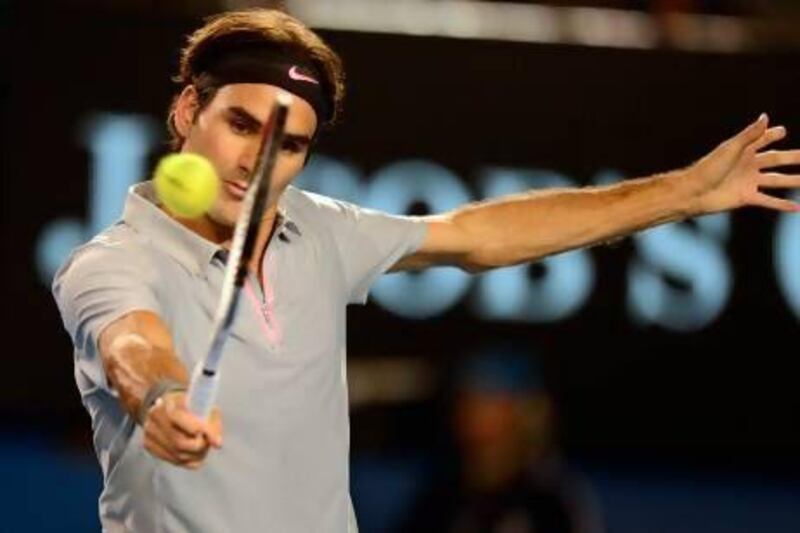As the year's first, and possibly most under-appreciated grand slam, works its way to the final stages, five random observations from the first 10 days.
Is the Australian Open the fairest of all?
In the Open era nobody has won the Australian Open three years in a row, the only major to not be conquered thusly. It is a convoluted, maybe irrelevant statistic but it is also pretty remarkable given tsohow the other Slams have each seen fairly long modern dynasties.
It suggests that the tournament isn't open to natural domination. Why? Well, until very recently it was the least important major on the circuit, skipped over gladly by leading players. Why else? The heat? The surfaces?
There probably is not any specific reason for it, but if you think of the men whom the feat has defied, it makes you wonder: Mats Wilander, Ivan Lendl, Jim Courier, Andre Agassi and Roger Federer are all multiple winners. In any case the aversion to dynasty has made it better viewing, though Novak Djokovic stands a good chance of ending it this year.
Old and still gold
Much was made of the prospect of the 31-year-old Roger Federer running into the 20-year-old Bernard Tomic and 22-year-old Milos Raonic in rounds three and four.
The younger pair have been widely touted as the ones to watch over the next couple of years. Gentle obituaries of Federer, meanwhile, have circulated for a couple of years now.
On the evidence of two straight-sets wins, predictions and expectations may need serious re-calibration. Federer was masterful. At times, he played both at their own games, beat them, got bored, then returned to his own game and beat them harder.
Federer's toughest tests will begin now, starting with Jo-Wilfried Tsonga, but if you were expecting a generational baton-passing in Melbourne, don't. On this form, Federer is not going anywhere.
Coolest players come from France
One way of looking at a gifted French generation is to say they have underperformed. None of them has yet won a slam, though Tsonga's gone closest by making it to the final in Australia in 2008.
But another way would be to appreciate just how cool - and great to watch - Richard Gasquet, Gael Monfils and Gilles Simon are.
As luck would have it, the four - the New Musketeers they were once optimistically dubbed - played each other over two rounds.
Simon and Monfils first played a third-round five-setter that was less a tennis match and more an electric odd-couple tragi-comedy (Simon won, but more Monfils lost, after taking the first two sets).
Then Tsonga edged out Gasquet in the fourth round in four sets, in slightly less entertaining fashion. Both matches were barmy and beautiful, the tennis elegant, intelligent and risky.
Above all the matches had spirit, a lightness usually absent at elite level, and were played by humans for whom winning or losing seemed only part of the reason for being there.
The return of the one-handed backhand
It is hardly an invasion - or a return really - but seeing Stan Wawrinka, Nicolas Almagro, Gasquet and Federer in the upper reaches of a slam was kind of life-affirming.
The one-handed backhand is not just a conceit. It gives a player so many options on return, as well as greater reach.
It is also (partly because of its rarity) the most naturally graceful tennis shot going: it is impossible to look ugly playing it. In fact, for five hours against Djokovic, Wawrinka's backhand was the most beautiful shot in the game as well as the most dangerous.
Only Federer remains now though and his overall game is so exquisite anyway that his backhand is but one of a million things to admire.
Still, it was good while it lasted.
The new adventures of old Andy Murray
He looks pretty much like the old one. He plays and talks like him as well. Except he is not.
He is a grand slam winner now and he is gone through to the quarter-finals with less clamour than ever before. He has almost snuck through unnoticed (or as unnoticed as the first British grand slam winner in a million years can be).
He has not always played like a champion, but that is conversely what is making him look more like a champion; note also that he has not yet played badly enough to drop a set.
In every round he has known what to do to get through and known that he will up his game just when he needs to.
Which, should he win his quarter-final today, he will need to because he will be facing either Federer or Tsonga in the last four.
Follow us
[ @SprtNationalUAE ]





